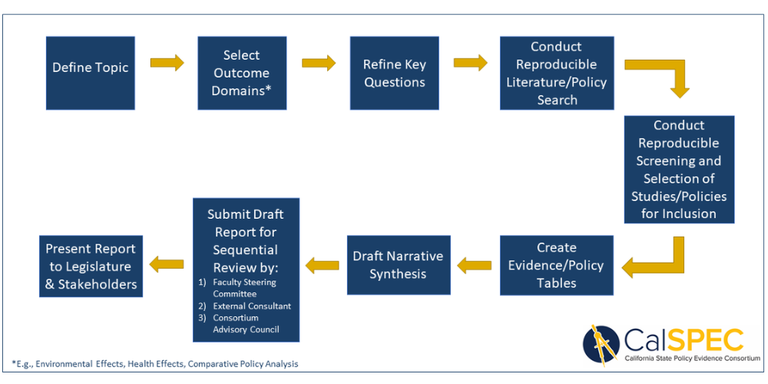The goal of CalSPEC is to provide a non-partisan, timely service to the State Legislature by summarizing evidence gleaned through rapid and systematic reviews of literature and policies relating to a specific topic selected by legislative committees. An important aim of the CalSPEC approach is to deploy a reproducible process that could allow outside groups to replicate the work and reach similar, if not identical, conclusions. Bringing a multi-disciplinary lens to the evidence review process, the approach relies on generally accepted methods for conducting rapid evidence reviews and policy evaluations. Our process for identifying a topic, reviewing the evidence, and synthesizing the evidence into a final report is outlined below. Opportunities for feedback from legislative committees and interested parties are built into the process to ensure responsiveness.
CalSPEC Workflow

The CalSPEC process operates on a 180-day timeline. The CalSPEC process begins when CalSPEC staff define the topic area in collaboration with California Assembly and Senate Committee partners. The CalSPEC Faculty Steering Committee and legislative staff then select key outcome domains for the report (e.g., environmental effects, health and welfare effects, economic effects, comparative policy analysis, etc.). University of California subject matter experts lead research teams assigned to each outcome domain. The research teams work with CalSPEC staff to identify and refine key questions to present to the legislative committee staff for refinement. Outside experts (either from within or external to UC) are recruited as necessary to provide additional consultation.
Each CalSPEC report research team collaborates with a UC librarian to conduct a reproducible literature search for the outcome domains. Predetermined inclusion and exclusion criteria are used to screen for and select relevant studies and information from the peer-reviewed and "grey” (i.e., government documents, foundation-sponsored reports, white papers, etc.) literature. Included peer-reviewed studies and policy reviews are summarized in evidence tables. Legislative staff are invited to review the evidence tables to provide feedback on the comprehensiveness of the review and preliminary findings and identify potential information gaps. The CalSPEC research team then drafts a narrative summary of results, which synthesizes existing evidence across the outcome domains of interest. The narrative summary and corresponding evidence tables together constitute the draft report. The report is submitted for sequential review by the Faculty Steering Committee, outside experts, and the Consortium Advisory Council, which reviews the report for clarity, neutrality, and responsiveness to the legislative request. After the draft report is reviewed and edits are implemented, CalSPEC staff submits the final report to legislative partners and participates in a legislative staff briefing on the findings.
